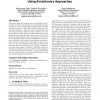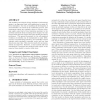130 search results - page 20 / 26 » Time Series Forecasting by means of Evolutionary Algorithms |
EMO
2005
Springer
14 years 1 months ago
2005
Springer
Abstract. The hypervolume measure is one of the most frequently applied measures for comparing the results of evolutionary multiobjective optimization algorithms (EMOA). The idea t...
ICAC
2009
IEEE
14 years 2 months ago
2009
IEEE
Increasingly, applications need to be able to self-reconfigure in response to changing requirements and environmental conditions. Autonomic computing has been proposed as a means...
CIDM
2009
IEEE
13 years 11 months ago
2009
IEEE
Abstract-- Automatic recognition of activities using time series data collected from exercise can facilitate development of applications that motivate people to exercise more frequ...
GECCO
2006
Springer
13 years 11 months ago
2006
Springer
Nadir point plays an important role in multi-objective optimization because of its importance in estimating the range of objective values corresponding to desired Pareto-optimal s...
GECCO
2007
Springer
14 years 1 months ago
2007
Springer
The modeling and analysis of large networks of autonomous agents is an important topic with applications in many different disciplines. One way of modeling the development of such...


